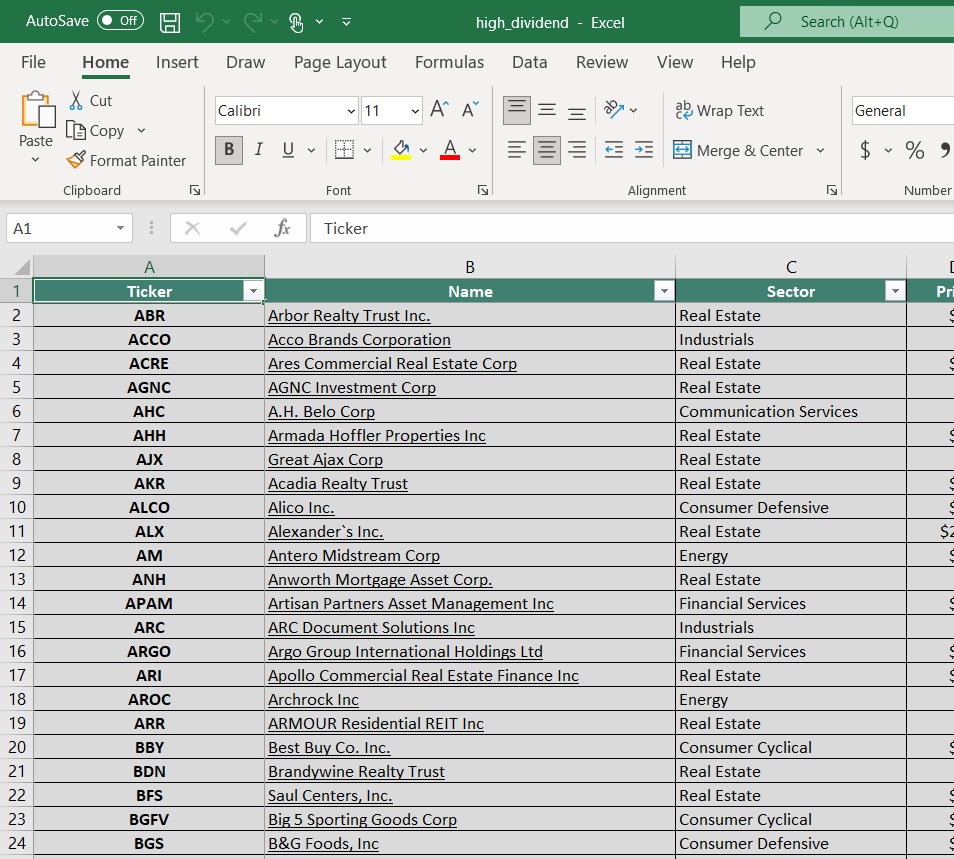10 Passive Income Stocks With 6%+ Dividend Yields

Published on February 27th, 2025 by Bob Ciura
Passive income stocks help you build rising income for retirement and/or financial freedom. Passive income stocks are meant to be purchased once and never sold.
The beauty of earning passive income is that it allows investors to generate income for doing almost nothing.
The average dividend yield in the S&P 500 Index remains low at just 1.3%. As a result, income investors should focus on higher-yielding securities, if they want additional income from their stock portfolios.
With this in mind, we compiled a list of high dividend stocks with dividend yields above 5%. You can download your free copy of the high dividend stocks list by clicking on the link below:
This article will discuss 10 passive income stocks with current yields over 6%.
Importantly, these 10 stocks have durable competitive advantages and strong underlying earnings, which support their dividends.
These 10 passive income stocks also have dividend payout ratios at or below 70%, which indicates a sustainable dividend right now.
The 10 passive income stocks are listed below by current dividend yield, in ascending order.
Table of Contents
You can instantly jump to any specific section of the article by using the links below:
Passive Income Stock #10: Newtek One Inc. (NEWT)
Newtek One provides financial and business services to the small- and medium-sized business market in the United States.
What makes NewTek a unique company is that a good portion of its income is derived from subsidiaries that provide a wide array of business services to its large client base.
The company also gets a significant amount of its income from being an issuer of SBA (Small Business Administration loans), which only very few BDCs are licensed to do. This is not your typical BDC that only generates income from interest rate spreads, but also from a much wider range of small business services.
On November 6th, 2024, Newtek reported its Q3 results for the period ending September 30th, 2024. This was the third quarter of the second year of Newtek reporting as a financial holding company following its completion of the National Bank of New York City acquisition.
For the quarter, the company produced a net income of $11.9 million, or $0.45 per share. This compares to net income of $10.9 million, or $0.43 per share, for the prior-year period.
Click here to download our most recent Sure Analysis report on NEWT (preview of page 1 of 3 shown below):
Passive Income Stock #9: Verizon Communications (VZ)
Verizon Communications was created by a merger between Bell Atlantic Corp and GTE Corp in June 2000. Verizon is one of the largest wireless carriers in the country.
Wireless contributes three-quarters of all revenues, and broadband and cable services account for about a quarter of sales. The company’s network covers ~300 million people and 98% of the U.S.
On January 24th, 2025, Verizon announced fourth quarter and full year results. For the quarter, revenue grew 1.7% to $35.7 billion, which beat estimates by $360 million.


Source: Investor Presentation
Adjusted earnings-per-share of $1.10 compared favorably to $1.08 in the prior year and was in-line with expectations. For the year, grew 0.6% to $134.8 billion while adjusted earnings-per-share $4.59 compared to $4.71 in 2023.
For the quarter, Verizon had postpaid phone net additions of 568K, which was better than the 449K net additions the company had in the same period last year. Retail postpaid net additions totaled 426K.
Wireless retail postpaid phone churn rate remains low at 0.89%. Wireless revenue grew 3.1% to $20.0 billion while the Consumer segment increased 2.2% to $27.6 billion.
Click here to download our most recent Sure Analysis report on VZ (preview of page 1 of 3 shown below):
Passive Income Stock #8: Edison International (EIX)
Edison International is a renewable energy company that is active in energy generation and distribution. It also operates an energy services and a technologies business. The company was founded in 1987 and is headquartered in Rosemead, CA.
On October 29, 2024, Edison International reported its financial results for the third quarter ended September 30, 2024.
The company delivered a GAAP net income of $516 million, or $1.33 per diluted share, marking a substantial increase from $155 million, or $0.40 per diluted share, in the same quarter last year.
On an adjusted basis, Edison achieved core earnings of $582 million, or $1.51 per diluted share, up from $531 million, or $1.38 per diluted share, in Q3 2023.
Revenue for the quarter was $5.20 billion, reflecting a 10.61% year-over-year growth and surpassing expectations by $192.39 million.
Click here to download our most recent Sure Analysis report on Edison International (EIX) (preview of page 1 of 3 shown below):
Passive Income Stock #7: Ford Motor Co. (F)
Ford Motor Company was first incorporated in 1903 and in the past 120 years, it has become one of the world’s largest automakers. It operates a large financing business as well as its core manufacturing division, which produces a popular assortment of cars, trucks, and SUVs.
Ford posted fourth quarter and full-year earnings on February 5th, 2025, and results were better than expected. Adjusted earnings-per-share came to 39 cents, which was seven cents ahead of estimates.
Revenue was up almost 5% year-over-year for the quarter to $48.2 billion, which also beat estimates by $5.37 billion. The fourth quarter was the highest revenue total the company has ever produced.
Ford Blue increased 4.2% to $27.3 billion in revenue for the fourth quarter, beating estimates of $25.9 billion. Model e revenue was down 13% year-over-year to $1.4 billion, $400 million less than expected.
Ford Pro revenue was up 5.3% to $16.2 billion, beating estimates for $15.6 billion.
For this year, Ford expects full-year adjusted EBIT of $7 to $8.5 billion, and for adjusted free cash flow of $3.5 billion to $4.5 billion, with capex of $8 to $9.5 billion.
Click here to download our most recent Sure Analysis report on Ford (preview of page 1 of 3 shown below):
Passive Income Stock #6: AES Corp. (AES)
The AES (Applied Energy Services) Corporation was founded in 1981 as an energy consulting company. It now has businesses in 14 countries and a portfolio of approximately 160 generation facilities.
AES produces power through various fuel types, such as gas, renewables, coal, and oil/diesel. The company has more than 36,000 Gross MW in operation.
AES Corporation reported third quarter results on October 31st, 2024, for the period ending September 30th, 2024. Adjusted EPS rose 18% to $0.71 for Q3 2024.
The company constructed and acquired 2.8 GW of renewable energy year-to-date, and is on course to add 3.6 GW of new projects online in 2024.


Source: Investor Presentation
Leadership expects to achieve the high end of its 2024 guidance for adjusted EPS of $1.87 to $1.97 for the full fiscal year. Additionally, the company reaffirms it also still expects annual EPS growth of 7% to 9% from 2023 through 2027.
The company is actively engaged in developing and acquiring new energy projects.
It currently has a backlog of 12.7 GW of renewables. AES expects to complete the majority of these projects through 2027.
Click here to download our most recent Sure Analysis report on AES (preview of page 1 of 3 shown below):
Passive Income Stock #5: Enterprise Products Partners LP (EPD)
Enterprise Products Partners was founded in 1968. It is structured as a Master Limited Partnership, or MLP, and operates as an oil and gas storage and transportation company.
Enterprise Products has a large asset base which consists of nearly 50,000 miles of natural gas, natural gas liquids, crude oil, and refined products pipelines.
It also has storage capacity of more than 250 million barrels. These assets collect fees based on volumes of materials transported and stored.


Source: Investor Presentation
Enterprise Products Partners reported strong fourth-quarter 2024 earnings, delivering $1.6 billion in net income, or $0.74 per common unit, representing a 3% increase over the prior year.
Adjusted cash flow from operations rose 4% to $2.3 billion, with the company declaring a quarterly distribution of $0.535 per unit, a 4% year-over-year increase.
Enterprise also continued its capital return strategy, repurchasing 2.1 million common units during the quarter and 7.6 million units for the full year, bringing total buybacks under its program to $1.1 billion.
For the full year, the company posted $9.9 billion in EBITDA, moving 12.9 million barrels of oil equivalent per day.
Click here to download our most recent Sure Analysis report on EPD (preview of page 1 of 3 shown below):
Passive Income Stock #4: Midland States Bancorp (MSBI)
Midland States Bancorp (MSBI) is the holding company of Midland States Bank, a community bank that was founded in 1881 and is headquartered in Effingham, Illinois.
It operates 53 branches in Illinois and Missouri and provides a wide range of banking products and services to individuals, businesses, municipalities and other entities. Midland States Bancorp has total assets of $7.5 billion.
In late January, Midland States Bancorp reported (1/23/25) results for the fourth quarter of fiscal 2024. Its net interest margin expand sequentially from 3.10% to 3.19% and its net interest income grew 2%.
However, the bank incurred massive charge-offs on loans ($103 million) and provisions for loan losses ($93.5 million).
As a result, it switched from earnings-per-share of $0.74 to an excessive loss per share of -$2.52, missing the analysts’ consensus by $3.19.
Midland States Bancorp has acquired seven smaller banks since 2009. As a result, it grew its asset base by 12% per year on average over the last nine years.
It had also grown its earnings-per-share by 6.9% per year on average during 2015-2023 but it incurred a loss in 2024 due to massive loan charge-offs and high deposit costs, which resulted from high interest rates.
Click here to download our most recent Sure Analysis report on MSBI (preview of page 1 of 3 shown below):
Passive Income Stock #3: Whirlpool Corp. (WHR)
Whirlpool Corporation, founded in 1955 and headquartered in Benton Harbor, MI, is a leading home appliance company with top brands Whirlpool, KitchenAid, and Maytag.
Roughly half of the company’s sales are in North America, but Whirlpool does business around the world under twelve principal brand names. The company, which employs about 44,000 people, generated nearly $17 billion in sales in 2024.


Source: Investor Presentation
On January 29th, 2025, Whirpool reported fourth quarter 2024 results. Sales for the quarter totaled $4.14 billion, down 18.7% from fourth quarter 2023.
Ongoing earnings per diluted share was $4.57 for the quarter, 19% higher than the previous year’s $3.85 per share.
Whirlpool issued its 2025 guidance, seeing ongoing earnings-per-share coming in at approximately $10.00 on revenue of $15.8 billion.
Additionally, Whirlpool expects cash provided by operating activities to total roughly $1 billion, with $500 to $600 million in free cash flow.
Click here to download our most recent Sure Analysis report on WHR (preview of page 1 of 3 shown below):
Passive Income Stock #2: MPLX LP (MPLX)
MPLX LP is a Master Limited Partnership that was formed by the Marathon Petroleum Corporation (MPC) in 2012. In 2019, MPLX acquired Andeavor Logistics LP.
The business operates in two segments:
- Logistics and Storage, which relates to crude oil and refined petroleum products
- Gathering and Processing, which relates to natural gas and natural gas liquids (NGLs)
In early February, MPLX reported (2/4/25) financial results for the fourth quarter of fiscal 2024. Adjusted EBITDA and distributable cash flow (DCF) per share grew 9% and 7%, respectively, primarily thanks to higher tariff rates and increased volumes of liquids and gas.
MPLX maintained a healthy consolidated debt to adjusted EBITDA ratio of 3.1x and a solid distribution coverage ratio of 1.5x.
Click here to download our most recent Sure Analysis report on MPLX (preview of page 1 of 3 shown below):
Passive Income Stock #1: Western Union Company (WU)
The Western Union Company is the world leader in the business of domestic and international money transfers. The company has a network of approximately 550,000 agents globally and operates in more than 200 countries.
About 90% of agents are outside of the US. Western Union operates two business segments, Consumer-to-Consumer (C2C) and Other (bill payments in the US and Argentina).
Western Union reported mixed Q4 2024 results on February 4th, 2025. Revenue increased 1% and diluted GAAP earnings per share increased to $1.14 in the quarter, compared to $0.35 in the prior year on higher revenue and a $0.75 tax benefit on reorganizing the international operations.
Revenue rose, despite challenges in Iraq on higher Banded Digital transactions and Consumer Services volumes.
CMT revenue fell 4% year-over-year even with 3% higher transaction volumes. Branded Digital Money Transfer CMT revenues increased 7% as transactions rose 13%. Digital revenue is now 25% of total CMT revenue and 32% of transactions.
Consumer Services revenue rose 56% on new products and expansion of retail foreign exchange offerings. The firm launched a media network business, expanded retail foreign exchange, and grew retail money orders.
Click here to download our most recent Sure Analysis report on WU (preview of page 1 of 3 shown below):
Final Thoughts & Additional Reading
If you are interested in finding high-quality dividend growth stocks and/or other high-yield securities and income securities, the following Sure Dividend resources will be useful:
High-Yield Individual Security Research
Other Sure Dividend Resources
Thanks for reading this article. Please send any feedback, corrections, or questions to [email protected].




































